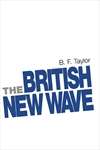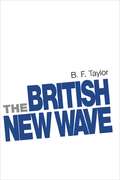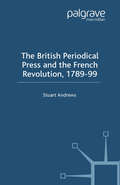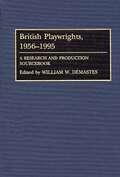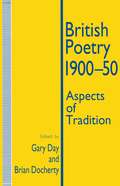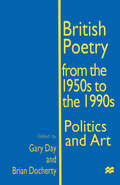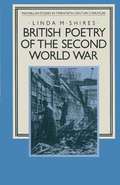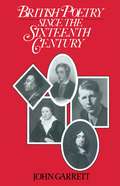- Table View
- List View
British Nautical Melodramas, 1820–1850: Volume III
by Arnold SchmidtDuring the 1820s and 30s nautical melodramas "reigned supreme" on London stages, entertaining the mariners and maritime workers who comprised a large part of the audience for small theatres with the same sentimental moments and comic interludes of domestic melodrama mixed with patriotic images that communicated and reinforced imperial themes. However, generally the study of British theatre history moves from medieval and renaissance plays directly to the realism and naturalism of late Victorian and modern drama. Readers typically encounter a gap between Restoration and eighteenth-century plays like those of Oliver Goldsmith and Richard Brinsley Sheridan, and late-nineteenth plays by Henrik Ibsen and Oscar Wilde. Nineteenth-century drama, with the possible exception of plays by Byron, Shelley, and Wordsworth, remains all but invisible. Until recently, melodramatic plays written and performed during this "gap" received little scholarly attention, but their value as reflections of Britain’s promulgation of imperial ideology — and its role in constructing and maintaining class, gender, and racial identities — have given discussions of melodrama force and momentum. The plays in included in these three volumes have never appeared in a critical anthology and most have not been republished since their original nineteenth-century editions. Each play is transcribed from the original documents and includes an author biography, a headnote about the play itself, full annotations with brief definitions of unfamiliar vocabulary, and explanatory notes. Comprehensive editorial apparatus details the nineteenth-century imperial, naval, political, and social history relevant to the plays’ nautical themes, as well as discussing nineteenth-century theatre history, melodrama generally, and the nautical melodrama in particular. Contemporary theatre practices — acting, audiences, staging, lighting, special effects — are also examined. An extensive bibliography of primary and secondary texts; a complete index; and contemporary images of the actors, theatres, stage sets, playbills, costumes, and locales have been compiled to aid study further. The appendices include maps of Britain, Europe, and the East and West Indies.
British Nautical Melodramas, 1820–1850: Volume II
by Arnold SchmidtDuring the 1820s and 30s nautical melodramas "reigned supreme" on London stages, entertaining the mariners and maritime workers who comprised a large part of the audience for small theatres with the same sentimental moments and comic interludes of domestic melodrama mixed with patriotic images that communicated and reinforced imperial themes. However, generally the study of British theatre history moves from medieval and renaissance plays directly to the realism and naturalism of late Victorian and modern drama. Readers typically encounter a gap between Restoration and eighteenth-century plays like those of Oliver Goldsmith and Richard Brinsley Sheridan, and late-nineteenth plays by Henrik Ibsen and Oscar Wilde. Nineteenth-century drama, with the possible exception of plays by Byron, Shelley, and Wordsworth, remains all but invisible. Until recently, melodramatic plays written and performed during this "gap" received little scholarly attention, but their value as reflections of Britain’s promulgation of imperial ideology — and its role in constructing and maintaining class, gender, and racial identities — have given discussions of melodrama force and momentum. The plays in included in these three volumes have never appeared in a critical anthology and most have not been republished since their original nineteenth-century editions. Each play is transcribed from the original documents and includes an author biography, a headnote about the play itself, full annotations with brief definitions of unfamiliar vocabulary, and explanatory notes. Comprehensive editorial apparatus details the nineteenth-century imperial, naval, political, and social history relevant to the plays’ nautical themes, as well as discussing nineteenth-century theatre history, melodrama generally, and the nautical melodrama in particular. Contemporary theatre practices — acting, audiences, staging, lighting, special effects — are also examined. An extensive bibliography of primary and secondary texts; a complete index; and contemporary images of the actors, theatres, stage sets, playbills, costumes, and locales have been compiled to aid study further. The appendices include maps of Britain, Europe, and the East and West Indies.
British Nautical Melodramas, 1820–1850: Volume II
by Arnold SchmidtDuring the 1820s and 30s nautical melodramas "reigned supreme" on London stages, entertaining the mariners and maritime workers who comprised a large part of the audience for small theatres with the same sentimental moments and comic interludes of domestic melodrama mixed with patriotic images that communicated and reinforced imperial themes. However, generally the study of British theatre history moves from medieval and renaissance plays directly to the realism and naturalism of late Victorian and modern drama. Readers typically encounter a gap between Restoration and eighteenth-century plays like those of Oliver Goldsmith and Richard Brinsley Sheridan, and late-nineteenth plays by Henrik Ibsen and Oscar Wilde. Nineteenth-century drama, with the possible exception of plays by Byron, Shelley, and Wordsworth, remains all but invisible. Until recently, melodramatic plays written and performed during this "gap" received little scholarly attention, but their value as reflections of Britain’s promulgation of imperial ideology — and its role in constructing and maintaining class, gender, and racial identities — have given discussions of melodrama force and momentum. The plays in included in these three volumes have never appeared in a critical anthology and most have not been republished since their original nineteenth-century editions. Each play is transcribed from the original documents and includes an author biography, a headnote about the play itself, full annotations with brief definitions of unfamiliar vocabulary, and explanatory notes. Comprehensive editorial apparatus details the nineteenth-century imperial, naval, political, and social history relevant to the plays’ nautical themes, as well as discussing nineteenth-century theatre history, melodrama generally, and the nautical melodrama in particular. Contemporary theatre practices — acting, audiences, staging, lighting, special effects — are also examined. An extensive bibliography of primary and secondary texts; a complete index; and contemporary images of the actors, theatres, stage sets, playbills, costumes, and locales have been compiled to aid study further. The appendices include maps of Britain, Europe, and the East and West Indies.
British Nautical Melodramas, 1820–1850: Volume I
by Arnold SchmidtDuring the 1820s and 30s nautical melodramas "reigned supreme" on London stages, entertaining the mariners and maritime workers who comprised a large part of the audience for small theatres with the same sentimental moments and comic interludes of domestic melodrama mixed with patriotic images that communicated and reinforced imperial themes. However, generally the study of British theatre history moves from medieval and renaissance plays directly to the realism and naturalism of late Victorian and modern drama. Readers typically encounter a gap between Restoration and eighteenth-century plays like those of Oliver Goldsmith and Richard Brinsley Sheridan, and late-nineteenth plays by Henrik Ibsen and Oscar Wilde. Nineteenth-century drama, with the possible exception of plays by Byron, Shelley, and Wordsworth, remains all but invisible. Until recently, melodramatic plays written and performed during this "gap" received little scholarly attention, but their value as reflections of Britain’s promulgation of imperial ideology — and its role in constructing and maintaining class, gender, and racial identities — have given discussions of melodrama force and momentum. The plays in included in these three volumes have never appeared in a critical anthology and most have not been republished since their original nineteenth-century editions. Each play is transcribed from the original documents and includes an author biography, a headnote about the play itself, full annotations with brief definitions of unfamiliar vocabulary, and explanatory notes. Comprehensive editorial apparatus details the nineteenth-century imperial, naval, political, and social history relevant to the plays’ nautical themes, as well as discussing nineteenth-century theatre history, melodrama generally, and the nautical melodrama in particular. Contemporary theatre practices — acting, audiences, staging, lighting, special effects — are also examined. An extensive bibliography of primary and secondary texts; a complete index; and contemporary images of the actors, theatres, stage sets, playbills, costumes, and locales have been compiled to aid study further. The appendices include maps of Britain, Europe, and the East and West Indies.
British Nautical Melodramas, 1820–1850: Volume I
by Arnold SchmidtDuring the 1820s and 30s nautical melodramas "reigned supreme" on London stages, entertaining the mariners and maritime workers who comprised a large part of the audience for small theatres with the same sentimental moments and comic interludes of domestic melodrama mixed with patriotic images that communicated and reinforced imperial themes. However, generally the study of British theatre history moves from medieval and renaissance plays directly to the realism and naturalism of late Victorian and modern drama. Readers typically encounter a gap between Restoration and eighteenth-century plays like those of Oliver Goldsmith and Richard Brinsley Sheridan, and late-nineteenth plays by Henrik Ibsen and Oscar Wilde. Nineteenth-century drama, with the possible exception of plays by Byron, Shelley, and Wordsworth, remains all but invisible. Until recently, melodramatic plays written and performed during this "gap" received little scholarly attention, but their value as reflections of Britain’s promulgation of imperial ideology — and its role in constructing and maintaining class, gender, and racial identities — have given discussions of melodrama force and momentum. The plays in included in these three volumes have never appeared in a critical anthology and most have not been republished since their original nineteenth-century editions. Each play is transcribed from the original documents and includes an author biography, a headnote about the play itself, full annotations with brief definitions of unfamiliar vocabulary, and explanatory notes. Comprehensive editorial apparatus details the nineteenth-century imperial, naval, political, and social history relevant to the plays’ nautical themes, as well as discussing nineteenth-century theatre history, melodrama generally, and the nautical melodrama in particular. Contemporary theatre practices — acting, audiences, staging, lighting, special effects — are also examined. An extensive bibliography of primary and secondary texts; a complete index; and contemporary images of the actors, theatres, stage sets, playbills, costumes, and locales have been compiled to aid study further. The appendices include maps of Britain, Europe, and the East and West Indies.
British Nautical Melodramas, 1820–1850
by Arnold SchmidtDuring the 1820s and 30s nautical melodramas "reigned supreme" on London stages, entertaining the mariners and maritime workers who comprised a large part of the audience for small theatres. These plays mixed sentimental moments and comic interludes of domestic melodrama with patriotic images that communicated and reinforced imperial themes. However, generally the study of British theatre history moves from medieval and renaissance plays directly to the realism and naturalism of late Victorian and modern drama. Readers typically encounter a gap between Restoration and eighteenth-century plays like those of Oliver Goldsmith and Richard Brinsley Sheridan, and late-nineteenth plays by Henrik Ibsen and Oscar Wilde. Nineteenth-century drama, with the possible exception of plays by Byron, Shelley, and Wordsworth, remains all but invisible. Until recently, melodramatic plays written and performed during this "gap" received little scholarly attention, but their value as reflections of Britain’s promulgation of imperial ideology — and its role in constructing and maintaining class, gender, and racial identities — have given discussions of melodrama force and momentum.The plays included in these three volumes have never appeared in a critical anthology and most have not been republished since their original nineteenth-century editions. Each play is transcribed from original documents and includes an author biography, a headnote about the play itself, full annotations with brief definitions of unfamiliar vocabulary, and explanatory notes. Comprehensive editorial apparatus details the nineteenth-century imperial, naval, political, and social history relevant to the plays’ nautical themes, as well as discussing nineteenth-century theatre history, melodrama generally, and the nautical melodrama in particular. Contemporary theatre practices — acting, audiences, staging, lighting, special effects — are also examined. An extensive bibliography of primary and secondary texts; a complete index; and contemporary images of the actors, theatres, stage sets, playbills, costumes, and locales have been compiled to aid study further.
The British New Wave: A certain tendency? (PDF)
by B. F. TaylorThis book offers an opportunity to reconsider the films of the British New Wave in the light of forty years of heated debate. By eschewing the usual tendency to view films like A Kind of Loving and The Entertainer collectively and include them in broader debates about class, gender, and ideology, this book presents a new and innovative look at this famous cycle of British films. For each film, a re-distribution of existing critical emphasis also allows the problematic relationship between these films and the question of realism to be reconsidered. Drawing upon existing sources and returning to long-standing and unchallenged assumptions about these films, this book offers the opportunity for the reader to return to the British New Wave and decide for themselves where they stand in relation to the films.
The British New Wave: A certain tendency?
by B. F. TaylorThis book offers an opportunity to reconsider the films of the British New Wave in the light of forty years of heated debate. By eschewing the usual tendency to view films like A Kind of Loving and The Entertainer collectively and include them in broader debates about class, gender, and ideology, this book presents a new and innovative look at this famous cycle of British films. For each film, a re-distribution of existing critical emphasis also allows the problematic relationship between these films and the question of realism to be reconsidered. Drawing upon existing sources and returning to long-standing and unchallenged assumptions about these films, this book offers the opportunity for the reader to return to the British New Wave and decide for themselves where they stand in relation to the films.
British Novelists in Hollywood, 1935–1965: Travelers, Exiles, and Expats
by L. CollettaBritish Novelists in Hollywood, 1935-1965 calls attention to the shifting grounds of cultural expression by highlighting Hollywood as a site that unsettled definitions and narratives of colonialism and national identity for prominent British novelists such as Christopher Isherwood, P.G. Wodehouse, Evelyn Waugh, and J.B. Priestley.
The British Periodical Press and the French Revolution 1789-99
by S. AndrewsThis study challenges the conventional polarities used to describe British politics of the 1790s; Pitt versus Fox, Burke versus Paine, Church versus Dissent, ruling class versus working class, Jacobin versus anti-Jacobin. Such polarities were sedulously promoted by Pitt's wartime government, which applied 'Jacobin' shamelessly to all its critics and opponents, and thus foreshadowed the McCarthyite tactic of guilt by association. The author seeks to make the less strident but more persuasive contemporary voices again audible. He takes seriously those who questioned the necessity for Burke's crusade to destroy the French republic, and who deplored Britain's alliance with the partitioners of Poland.
British Periodicals and Romantic Identity: The "Literary Lower Empire" (Nineteenth-Century Major Lives and Letters)
by M. SchoenfieldWhen Lord Byron identified the periodical industry as the "Literary Lower Empire," he registered the cultural clout that periodicals had accumulated by positioning themselves as both the predominant purveyors of scientific, economic, and social information and the arbiters of literary and artistic taste. British Periodicals and Romantic Identity explores how periodicals such as the Edinburgh, Blackwood s, and the Westminster became the repositories and creators of "public opinion." In addition, Schoenfield examines how particular figures, both inside and outside the editorial apparatus of the reviews and magazines, negotiated this public and rapidly professionalized space. Ranging from Lord Byron, whose self-identification as lord and poet anticipated his public image in the periodicals, to William Hazlitt, equally journalist and subject of the reviews, this engaging study explores both canonical figures and canon makers in the periodicals and positions them as a centralizing force in the consolidation of Romantic print culture.
British Pirates in Print and Performance (Nineteenth-century Major Lives And Letters Ser.)
by M. PowellFictional or real, pirates haunted the imagination of the 18th and 19th century-British public during this great period of maritime commerce, exploration, and naval conflict. British Pirates in Print and Performanc e explores representations of pirates through dozens of stage performances, including adaptations by Byron, Scott, and Cooper.
British Playwrights, 1880-1956: A Research and Production Sourcebook
by William W. Demastes Katherine KellyFrom 1880 to 1956, when John Osborne transformed the British theater world with Look Back in Anger, British playwrights made numerous lasting contributions and provided a foundation for the innovations of dramatists during the latter half of the 20th century. This reference profiles the life and work of some 40 British playwrights active during the late 19th and early 20th centuries, many of whom are also known for their work as novelists and poets. Included are figures such as W. H. Auden, Max Beerbohm, Noel Coward, T. S. Eliot, John Galsworthy, Graham Greene, D. H. Lawrence, W. Somerset Maugham, George Bernard Shaw, and Oscar Wilde. Each entry provides a biographical overview; a list of major plays and summaries of their critical reception; a list of minor plays, adaptations, and productions; an assessment of the playwright's career; and archival and bibliographical information.Included in this reference book are alphabetically arranged entries for some 40 British playwrights active from 1880 through 1956. Entries are written by expert contributors, with each entry providing a biographical overview; a list of major plays, premieres, and significant revivals, along with a summary of the critical reception of these works; a listing of additional plays, adaptations, and productions; an assessment of the playwright's career and contributions, with reference to published evaluations in magazines, journals, dissertations, and books; a listing of locations housing unpublished archival material, if available; a selected bibliography of the dramatist's published plays and of essays and articles by the playwright on aspects of the theater; a selected bibliography of secondary sources; and, when available, a listing of previously published bibliographies on the playwright.
British Playwrights, 1956-1995: A Research and Production Sourcebook
by William W. DemastesThe year 1956 marked a point when British drama and theater fell into the hands of a group of young playwrights who revolutionized the stage. During that time, playwrights such as Samuel Beckett and Harold Pinter made the British theater as rich, varied, and vital as any national theater in history. This reference chronicles the history of British theater from 1956 to 1995 by providing detailed information about the playwrights of that period.Included are entries for some three dozen British playwrights active between 1956 and 1995. Entries are arranged alphabetically to facilitate use. Each entry supplies biographical information, the production history for particular plays, a survey of the playwright's critical reception, an assessment of the dramatist's work, and primary and secondary bibliographies. A selected, general bibliography at the end of the volume directs the reader to important sources of additional information about this period in theater history.
British Poetry, 1900-50: Aspects of Tradition
by Gary Day Brian DochertyThis collection focuses on British poetry from the Georgians to the Second World War. The introduction provides the framework for the articles which follow by considering the question of the relation between poetry and society as it appears in the work of F.R. Leavis, T.W. Adorno and Antony Easthope. Written by experts, the essays cover poetic movements and individual authors, both mainstream and neglected, and address the difficult problem of making value judgements while situating poetry in its historical context.
British Poetry from the 1950s to the 1990s: Politics and Art
by Gary Day Brian DochertyThis collection looks at the developments in British poetry from the Movement until the present. The introduction not only provides a context for these changes but also argues that poetry criticism has been debilitated by the quest for political respectability, a trend which can only be reversed by reconsidering the idea of tradition. The essays themselves focus on general themes or individual authors. Written in a clear and informed manner, they provoke the reader into a fresh awareness of the nature of poetry and its relation to society.
The British Press (UK Higher Education OUP Humanities & Social Sciences Media, Film & Cultural Studies)
by Mick Temple"Mick Temple's book makes an important contribution to the debate on the critical historical role and uncertain future of newspapers and the key place of quality journalism within that debate."Jeremy Dear, General Secretary of the National Union of Journalists, UK"This book provides a brilliant synthesis of academic and journalistic debate on the past, present and future of the British newspaper. Impressively up-to-date, it is an accessible and well sign-posted introduction to students of the news media and political communication and should become an essential addition to their reading."Martin Conboy, University of Sheffield, UK"A thorough and thoughtful investigation into the British press and its contribution to our social and political culture."Simon Kelner, Editor-in-Chief, The IndependentThis exciting book offers a practical introduction to the history, theory, politics and potential future of British newspapers. Focussing on the relationship between the press and political history, it examines their social and political impact, assessing the press’s contribution to enlarging and informing the public sphere. The author provides a theoretical critique of press developments. The first part of the text leads you through key historical moments from the English Civil War to Wapping and beyond, while the second half takes an in-depth look at current empirical and theoretical concerns. Scholarly yet accessible, Mick Temple is not afraid to take a position on today’s contentious issues.The book takes a more positive perspective on the British press than has often been the case, highlighting the online strength of great brand names like the Telegraph, Guardian, Sun and Mail. Temple argues that throughout their history, our newspapers have been vital conduits for public opinion and, on occasion, catalysts for social change.The British Press is key reading for journalism, media and social science students.
The British Press and the Greek Crisis, 1943–1949: Orchestrating the Cold-War ‘Consensus’ in Britain (Palgrave Studies in the History of the Media)
by Gioula KoutsopanagouThis book provides the first detailed analysis of how interactions between government policy and Fleet Street affected the political coverage of the Greek civil war, one of the first major confrontations of the Cold War. During this period the exponential growth of media influence was an immensely potent weapon of psychological warfare. Throughout the 1940s the press maintained its position as the most powerful medium and its influence remained unchallenged. The documentary record shows that a British media consensus was more fabricated than spontaneous, and the tools of media persuasion and manipulation were extremely important in building acceptance for British foreign policy. Gioula Koutsopanagou examines how this media consensus was influenced and molded by the British government and how Foreign Office channels were key to molding public attitudes to British foreign policy. These channels included system of briefings given by the News Department to the diplomatic correspondents, and the contacts between embassies and the British foreign correspondents.
The British Press, Public Opinion and the End of Empire in Africa: The 'Wind of Change', 1957-60 (Britain and the World)
by Rosalind CoffeyThis book provides fresh insights into how the British press affected both British perceptions of decolonisation in Africa and British policy towards it during the ‘wind of change’ period. It also reveals, for the first time, the extent to which British newspaper coverage was of relevance to African and white settler readerships. British newspapers informed the political strategies and civic cultures of African activists,nationalists, liberal whites in Africa, the staunchest of white settler communities, and the first governments of independent African states and their opponents. The British press, British public opinion and British journalists became etched into the lived experiences of the end of empire affecting Anglo-African and Anglo-settler relations to this day. Arguing that the press cast a transnational web of influence over the decolonisation process in Africa, the author explores the relationships between the British, African and settler public and political spheres, and highlights the mediating power of the British press during the late 1950s. The book draws from a range of British newspapers, official government documents, newspaper archives, interviews, memoirs, autobiographies and articles printed in African and white settler papers. It will be of interest to historians of decolonisation, Africa, the media and the British Empire.
British Pronoun Use, Prescription, and Processing: Linguistic and Social Influences Affecting 'They' and 'He'
by L. PatersonThis study considers the use of they and he for generic reference in post-2000 written British English. The analysis is framed by a consideration of language-internal factors, such as syntactic agreement, and language-external factors, which include traditional grammatical prescriptivism and the language reforms resulting from second-wave feminism.
British queer history: New approaches and perspectives (PDF)
by Brian LewisThis collection of essays takes stock of the ‘new British queer history’. It is intended both for scholars and students of British social and cultural history and of the history of sexuality, and for a broader readership interested in queer issues. In offering a snapshot of the field, this volume demonstrates the richness and promise of one of the most vibrant areas of modern British history and the complexity and breadth of discussion, debate and approach. It showcases challenging think-pieces from leading luminaries alongside some of the most original and exciting research by established and emerging young scholars. The book provides a plethora of fresh perspectives and a wealth of new information, suggests enticing avenues for research and – in bringing the whole question of sexual identity to the forefront of debate – challenges us to rethink queer history’s parameters.
British queer history: New approaches and perspectives
by Brian LewisThis collection of essays takes stock of the ‘new British queer history’. It is intended both for scholars and students of British social and cultural history and of the history of sexuality, and for a broader readership interested in queer issues. In offering a snapshot of the field, this volume demonstrates the richness and promise of one of the most vibrant areas of modern British history and the complexity and breadth of discussion, debate and approach. It showcases challenging think-pieces from leading luminaries alongside some of the most original and exciting research by established and emerging young scholars. The book provides a plethora of fresh perspectives and a wealth of new information, suggests enticing avenues for research and – in bringing the whole question of sexual identity to the forefront of debate – challenges us to rethink queer history’s parameters.
British Romantic Art and the Second World War
by Stuart SillarsAn examination of the ways in which the artists and writers of the 1940s developed and extended approaches from earlier English romanticism to provide a direct and compassionate response to the reality of contemporary destruction.



